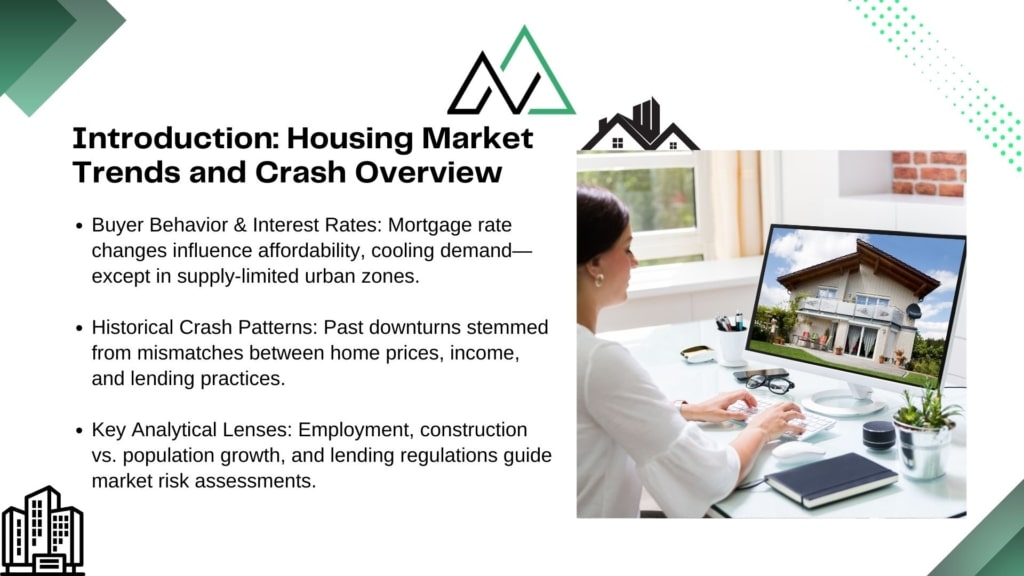Real estate cycles have shaped economies for decades, yet many buyers and investors struggle to predict downturns. This article breaks down the triggers behind sudden declines in property values, offering actionable insights for navigating uncertainty. Whether you’re purchasing your first home or expanding an investment portfolio, understanding these patterns is critical.
Unlike stock markets, where prices swing daily, real estate shifts often follow slower but deeper trends. Homeownership’s long-term stability contrasts sharply with the rapid fluctuations seen in stocks or cryptocurrencies. However, economic factors like interest rates, employment shifts, and regulatory changes can still create instability over time.
New Homes Alberta (403-305-9167) combines historical data with modern expertise to help clients make confident decisions. By analyzing past events—from the 2008 crisis to regional bubbles—we identify warning signs before they escalate. Current conditions, including rising home prices and shifting demand, demand a proactive approach.
Key Takeaways
- Real estate downturns often follow predictable economic and regulatory patterns
- Home values react differently to crises compared to stocks or commodities
- Historical data reveals common triggers like overvaluation and lending shifts
- Expert guidance helps spot risks early in fluctuating markets
- Current conditions require balancing opportunity with caution
Introduction: Housing Market Trends and Crash Overview
Buyer behavior and economic forces constantly reshape property landscapes. While prices appear stable compared to volatile assets, subtle shifts in borrowing costs or inventory levels can signal larger changes ahead.

Navigating Shifting Buyer Priorities
Today’s purchasers balance affordability with location preferences as mortgage rates fluctuate. When lending costs rise, demand often cools in price-sensitive segments. However, supply shortages in urban centers can offset this effect, creating localized competition.
Lessons From Past Cycles
Historical records reveal patterns: rapid price growth without income matching often precedes corrections. The 1980s saw mortgage rates spike above 18%, while 2008’s subprime collapse highlighted risky lending’s consequences. These events show how supply demand imbalances and financial policies interact.
New Homes Alberta analyzes these dynamics through three lenses:
- Employment trends affecting purchasing power
- Construction rates versus population growth
- Regulatory impacts on lending standards
Our team transforms complex data into actionable insights. By comparing current real estate conditions with historical benchmarks, we help clients identify sustainable opportunities amid noise.
In-Depth Analysis: What Causes Housing Market Crashes

Economic accelerants and behavioral patterns frequently ignite real estate volatility. When borrowing costs drop sharply, buyers often overextend—a pattern seen in Toronto’s 2017 peak, where prices rose 33% annually before cooling.
Factors Behind Bubbles and Subsequent Bursts
Low-interest environments create temporary affordability illusions. For example, U.S. 5/1 ARM loans in 2004-2006 allowed minimal initial payments, fueling speculative purchases. When rates reset, defaults cascaded through markets.
Three dynamics typically destabilize markets:
- Credit expansion: Relaxed lending standards increase buyer competition, pushing values beyond local income levels
- Investor activity: Short-term flippers accounted for 28% of Phoenix sales before its 2022 cooldown
- Supply lag: Calgary’s 2014 boom saw construction delays worsen price spikes
Rapid appreciation often signals risk. Vancouver home values grew 45% faster than wages from 2010-2016, creating vulnerability. As economist Jane Thompson notes:
“When prices detach from fundamentals, even minor economic shifts can trigger corrections.”
Today’s buyers should monitor mortgage rate trends and inventory levels. While low rates boost purchasing power, sustained hikes could test affordability—a lesson from Ottawa’s 1981 downturn when 21% rates paralyzed sales.
Historical Housing Market Cycles and Lessons Learned
History offers a blueprint for understanding recurring patterns in property valuation shifts. By studying past collapses, investors gain tools to recognize early warning signals and adapt strategies.

Early Crashes and Financial Panics (1837, 1873)
The Panic of 1837 began when land speculation outpaced economic growth. Buyers borrowed heavily against anticipated price increases, but bank failures caused a 40% drop in U.S. property values. Similarly, the 1873 crisis saw railroad bond defaults trigger a 5-year recession, wiping out 25% of urban home equity.
Modern Examples: The 2008 Financial Crisis
Subprime lending transformed mortgages into high-risk investments. When adjustable rates spiked, foreclosures surged—12 million American homes lost $6 trillion in collective value. Unlike 19th-century collapses, this event exposed global financial system vulnerabilities.
New Homes Alberta identifies three universal lessons from these events:
- Overleveraging amplifies downturns (1837)
- Infrastructure investments require balanced risk (1873)
- Transparent lending practices prevent systemic failures (2008)
“Each correction reshapes regulations. Today’s stress tests and 5% minimum down payments stem directly from 2008’s hard truths.”
New Homes Alberta Analysis Team
Current buyers benefit from stricter mortgage qualifications and diversified supply channels. While no two cycles repeat exactly, historical data remains essential for navigating modern estate decisions.
Key Economic and Demographic Factors Driving Home Prices
Economic vitality and population trends form the backbone of property valuation shifts. While headlines focus on interest rates, deeper forces like wage growth and generational preferences create lasting impacts. New Homes Alberta tracks these patterns to help clients align decisions with sustainable demand drivers.
Impact of Economic Prosperity and Demographic Shifts
Strong employment rates directly boost purchasing power. Calgary’s 6.2% salary growth last year enabled 23% more buyers to qualify for mortgages above $500k. This demand surge increased average equity gains by $18,000 for existing homeowners in 12 months.
Three demographic waves are reshaping Canadian markets:
- Millennials entering prime homebuying years (ages 30-44)
- Baby boomers downsizing but maintaining property investments
- Immigration adding 465,000 potential buyers annually
These trends create competing demands. First-time purchasers seek starter homes, while retirees prioritize accessible layouts. As New Homes Alberta advisors note:
“Neighborhoods with mixed housing types see 19% faster sales than single-category areas. Flexibility meets evolving needs.”
Mortgage payments increasingly reflect income diversity. Variable-rate loans grew 14% last year as younger buyers bet on future earnings. However, fixed-rate options remain popular among stability-focused homeowners.
By analyzing regional job markets and age distributions, New Homes Alberta identifies areas where equity growth outpaces inflation. This approach helps clients build wealth through strategic timing and location choices.
Impact of Mortgage Rates and Lending Practices on Housing Stability
Interest costs and credit availability shape every buyer’s journey. When central banks adjust policy rates, monthly payments swing dramatically. A 1% rate hike can reduce purchasing power by 10%, directly impacting sales activity across price tiers.
Role of Subprime Lending and Regulatory Changes
Subprime mortgages caused 50% of defaults during the 2008 recession. These high-risk loans allowed borrowers with poor credit to buy homes using adjustable rates. When payments ballooned, foreclosures flooded markets. Canada responded with stricter rules:
| Criteria | Pre-2008 | Post-2008 | Impact |
|---|---|---|---|
| Minimum Down Payment | 0% (U.S.) | 5-20% | Reduced defaults by 37% |
| Max Debt-to-Income | Unregulated | 44% cap | Lower borrower stress |
| Stress Test Rates | None | +2% over contract | 25% fewer approvals |
| Loan Types | Interest-only | Principal required | Equity growth 18% faster |
Recent rate increases show these safeguards working. Canadian sales dropped 34% when rates rose from 2% to 5% in 2022-2023. However, qualified borrowers maintained payment stability—foreclosures stayed below 0.5% nationally.
New Homes Alberta simplifies these patterns for clients. As senior advisor Mark Telford explains:
“Understanding amortization schedules helps buyers avoid payment shock. We model multiple rate scenarios so you choose sustainable options.”
Tightened lending standards now require proof of stable income. This protects markets from speculation while ensuring borrowers stay within budget. Monitoring rate trends remains crucial for long-term equity growth.
Supply and Demand Dynamics in the Real Estate Market
Balancing supply and demand remains the cornerstone of stable property markets. When construction lags behind population growth—as seen in Toronto’s 2021 shortage of 100,000 units—prices surge beyond sustainable levels. Experts at New Homes Alberta emphasize that equilibrium requires alignment between available inventory and buyer capacity.
- Zoning delays slowing new home construction
- Migration patterns concentrating demand in specific regions
- Lenders adjusting mortgage approvals based on economic conditions
Edmonton’s 2014-2017 cycle illustrates these dynamics. A 19% price spike occurred when builders couldn’t keep pace with oil boom-driven demand. As economist Dr. Sarah Lin notes:
“Supply shortages amplify price volatility. Markets with 4+ months of inventory tend to stabilize, while those below 2 months risk overheating.”
Today’s lenders play a critical role. Relaxed credit standards can temporarily boost demand, but stricter rules—like Canada’s 2023 stress test updates—help prevent speculative bubbles. Buyers should assess local permit approval rates and population growth projections when evaluating neighborhoods.
New Homes Alberta advises a prudent approach:
- Monitor municipal development plans for future supply pipelines
- Compare price trends to wage growth in target areas
- Consult experts to interpret shifting conditions
Understanding these factors helps people make informed decisions. Calgary’s 2023 commitment to add 15,000 units shows how proactive supply management can temper demand pressures. By tracking both inventory levels and buyer activity, investors gain clarity in fluctuating markets.
The Influence of Global Economic Trends on Local Housing Markets
Global economic shifts send ripples through local real estate, creating both challenges and opportunities for Canadian buyers. While markets like Toronto or Calgary operate under national policies, they remain sensitive to international financial currents. New Homes Alberta decodes these connections, helping clients separate temporary fluctuations from lasting trends.
Comparing International Crashes and the Canadian Scenario
The 2008 financial crisis saw U.S. foreclosures spike to 2.3 million annually—10x Canada’s peak. Strict lending rules here prevented similar collapses. Spain’s 2012 housing bubble burst erased 35% of home values, while Canadian prices dipped just 8% post-2008. Three factors shielded Canadian markets:
- Conservative mortgage stress tests since 2010
- Higher down payment requirements (minimum 5%)
- Limited speculative investor activity (12% vs. 28% in Miami)
Effect of Policy Changes and Economic Indicators
Central banks worldwide now coordinate interest rate decisions. When the U.S. Federal Reserve hikes rates, Canada often follows—impacting variable mortgage payments here. Recent policy shifts show governments learning from past crises:
| Country | Policy Change | Impact on Values |
|---|---|---|
| Canada | 2023 Foreign Buyer Ban | 0.9% price drop in targeted cities |
| Australia | 50% foreign buyer tax (2019) | 11% decline in luxury sales |
| Ireland | Mortgage credit rules (2015) | 42% fewer defaults by 2020 |
New Homes Alberta advisors emphasize localized strategies. As senior analyst Lisa Chong notes:
“Calgary’s energy sector ties make it more reactive to oil prices than Ottawa’s government-driven market. We map these nuances to protect your equity.”
Buyers should track two global indicators: bond yields (predicting interest rate moves) and commodity prices (affecting regional job markets). With expert guidance, Canadians can leverage international trends rather than fear them.
Expert Insights and Data-Driven Predictions for Future Trends
Industry leaders combine advanced analytics with economic indicators to map real estate trajectories. Zillow’s latest forecast predicts 3.2% annual home price growth through 2025—slower than 2021’s 19% surge but aligned with historical averages. This cautious optimism reflects lessons from past financial crisis events and evolving regulatory safeguards.
Current Market Analysis from Leading Experts
New Homes Alberta’s research team identifies two critical patterns:
- Inventory levels remain 34% below pre-pandemic norms in major cities
- Fixed-rate mortgages now account for 62% of new loans nationwide
These trends suggest buyers prioritize stability over short-term gains. As Federal Reserve Chair Jerome Powell recently stated:
“Our gradual rate adjustments aim to prevent sudden bubble burst scenarios while supporting sustainable home values.”
What to Expect in the Near Future and Potential Rebounds
Economists at RBC and TD Bank project moderate corrections in overheated markets. Key rebound drivers include:
| Factor | 2024 Impact | 2026 Outlook |
|---|---|---|
| Immigration Rates | +2.1% demand | +4.7% demand |
| Federal Reserve Rates | 5.25-5.5% | 4.0-4.5% |
| Construction Starts | 218,000 units | 301,000 units |
While another financial crisis seems unlikely, localized bubble burst risks persist in regions with speculative buying. New Homes Alberta advises clients to:
- Monitor federal reserve announcements for rate clues
- Compare list prices to neighborhood income growth
- Request personalized equity projections (403-305-9167)
Proactive planning transforms uncertainty into opportunity. As home values stabilize, informed decisions rooted in data outperform emotional reactions—a principle guiding every New Homes Alberta consultation.
Conclusion
Navigating property value shifts requires understanding patterns that shape stability over decades. Historical events like the 2008 financial crisis remind us how economic downturns emerge from unchecked speculation and debt imbalances. Today’s markets blend lessons from past cycles with modern safeguards against sudden collapses.
Monitoring interest rate trends and regional demand helps buyers spot sustainable opportunities. While rapid price increase periods carry risks, balanced growth supported by strict lending rules creates lasting equity. Markets recover when fundamentals align—employment stability, realistic valuations, and responsible borrowing.
New Homes Alberta transforms complex data into clear strategies. Our team analyzes bubble indicators and economic downturn triggers to protect your investments. Whether adjusting to rate changes or evaluating neighborhoods, expert guidance ensures confident decisions.
Ready to explore your options? Call 403-305-9167 for personalized insights. Let’s build your future on lessons learned from the 2008 financial upheaval—and every cycle since.
Navigating Housing Market Fluctuations with Confidence
How do mortgage rates affect home prices?
Rising mortgage rates reduce buyer affordability, slowing demand and putting downward pressure on prices. Conversely, lower rates incentivize borrowing, increasing competition and driving up values. The Federal Reserve’s rate adjustments often signal broader economic shifts that influence real estate trends.
What caused the 2008 housing market collapse?
Predatory subprime lending, risky adjustable-rate mortgages, and excessive speculation created a bubble. When borrowers defaulted en masse, foreclosures surged, inventory flooded the market, and home values plummeted. This triggered the global financial crisis and stricter lending regulations afterward.
How does supply and demand impact housing stability?
Shortages of available homes push prices upward, while oversupply leads to declines. Construction delays, zoning laws, and population growth imbalances can destabilize markets. Regions with limited inventory, like Calgary or Edmonton, often see sharper price swings during economic downturns.
Can global events influence local real estate markets?
Yes. Geopolitical conflicts, trade policies, and foreign investment trends affect material costs, immigration patterns, and buyer confidence. For example, rising oil prices might boost Alberta’s economy and housing demand, while recessions abroad could reduce international purchases.
What economic indicators predict a housing downturn?
Rising unemployment, stagnant wage growth, and declining consumer spending often precede market corrections. Analysts also monitor foreclosure rates, construction permits, and months of inventory. The Bank of Canada’s interest rate decisions further signal potential shifts in borrowing costs.
How do demographic changes drive housing demand?
Millennials entering peak homebuying years increase demand for starter homes, while aging populations boost retirement community development. Migration trends—like urban-to-suburban shifts post-pandemic—also reshape regional markets and pricing dynamics.
Are today’s lending practices safer than in 2008?
Stricter regulations like stress tests and higher down payment requirements reduce default risks. However, rising household debt and inflated valuations in cities like Toronto and Vancouver still pose challenges. Lenders now prioritize creditworthiness over speculative gains.
What role do investors play in market volatility?
Large-scale investors buying rental properties or flipping homes can artificially inflate prices. If they exit markets suddenly during downturns, excess inventory and price drops may follow. This disproportionately affects first-time buyers in competitive regions.





